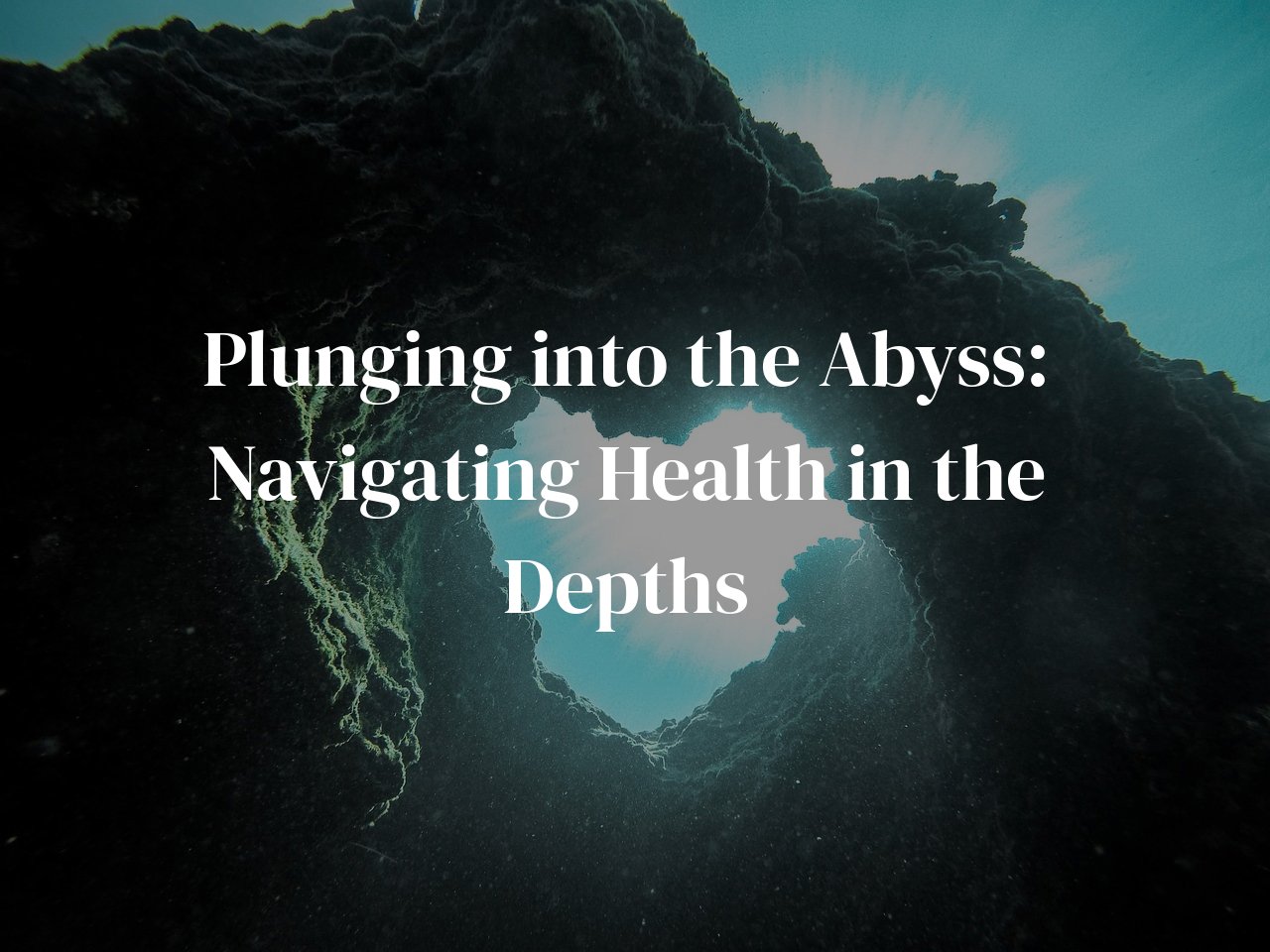
Diving into the profound mysteries of the ocean is akin to exploring another world – a world of silence, darkness, and immense pressure. This blog post will delve into the less-discussed realm of how the silent depth informs our understanding of human resilience and vulnerability. We’ll explore the paradoxical effects of deep sea diving on the human body and how the physiological challenges divers face under immense oceanic pressure extend our understanding of healthcare challenges on land.
By reading through this post, you will gain fascinating insights into the complex relationship between extreme environments and human health. Moreover, the lessons learned from deep sea diving medical challenges can find applications in daily healthcare practices, potentially enriching your knowledge of self-care and medical awareness in high-pressure situations – both literal and metaphorical.
Table of Contents
Decompression Sickness: A Risk Beneath the Waves
As someone who’s felt the allure of the deep blue, I’ve come to know intimately the invisible dangers that dwell beneath the waves. Decompression sickness (DCS), often dubbed ‘the bends,’ is a treacherous condition that lurks in the shadow of every ascent a diver makes. The dangers begin when divers descend to the ocean’s profound depths and breathe air at high pressures. Nitrogen, a usually benign component of our breathing mix, can turn into a devious foe when subjected to these conditions, dissolving into the blood and forming silent bubbles as pressure diminishes during ascent.
These are not just any bubbles—their formation within the bloodstream can block vessels and wreak havoc in the body, mimicking a rogue’s gallery of medical maladies. Divers may experience joint pain, known colloquially as ‘the bends,’ but symptoms can escalate to staggering neurological and pulmonary complications, often without warning. The challenge in diagnosing and treating DCS lies in its chameleonic nature – no two cases present exactly alike, making it as unpredictable as the sea itself.
Recalling my own brush with DCS instills a sense of humility; the moment when my own knee swelled and ached, it was a harsh reminder of the respect the ocean demands. Treating such an affliction begins with recognition and prompt action. The cornerstone of therapy is recompression, typically in a hyperbaric chamber, which aims to re-dissolve those insidious nitrogen bubbles and gradually return the body to a state of equilibrium. It’s a dance with physics and physiology that must be choreographed with precision.
The traditions of diving medicine advocate for slow, deliberate ascents and prescribed intervals between dives, all in an effort to mitigate DCS risks. Moreover, while decompression sickness is a diver’s risk, its principles echo in everyday health. Understanding pressure and its effects on the body extends beyond the depths—take it from me, lessons from diving have taught me more about the fragility and resilience of the human body than I’d ever imagined.
Oxygen Toxicity: The Irony of Life-Giving Gas
In my journey beneath the waves, I’ve come to respect the duality of oxygen – it is as much a source of life as it can be a bringer of harm. As a diver, you learn that the very essence of our breaths, the oxygen that fuels our cells, can turn toxic under pressure. In the deep blue, beyond recreational diving limits, we use mixed gases because pure oxygen becomes poisonous. This harsh reality is known as oxygen toxicity.
My personal encounters with the edges of this phenomenon taught me its subtleties. When diving at greater depths, my dive computer keeps track of oxygen exposure, a constant reminder that even ‘life-giving gas’ has its dark side. The body can experience convulsions, vision issues, and disorientation when confronted with high partial pressures of oxygen – a risk not to be taken lightly. It’s a bitter irony that the very element that sustains us can become deleterious, a viper waiting to strike in the paradise of the deep.
The capricious nature of oxygen under pressure informs much of my training. I’ve learned that symptoms can manifest suddenly, without warning, making vigilance and constant awareness paramount. The training deals with recognizing early signs, like a persistent cough or a twitch of the facial muscles, nuances you wouldn’t normally consider on land.
To me, it’s fascinating how this knowledge transcends the depths and influences health practices on solid ground. Understanding and respecting our physiological reactions to oxygen has contributed to breakthroughs in treating conditions hyperbarically, setting a foundation for handling cases of carbon monoxide poisoning or promoting wound healing. The abyss has indeed been a peculiar teacher, revealing that our bodies hold mysterious power, but also a potential fragility, under the weight of the sea and the burden of oxygen.
The Psychological Depths: Managing Mental Health in Isolation
Deep sea diving not only exposes the human body to physical stresses but also to profound psychological challenges. In the eerie silence beneath the surface, where one is accompanied only by the sound of their own breathing, a sense of isolation can quickly become overwhelming. As a blogger who deeply understands such conditions, I draw a connection between the solace found within the depths and the solitude one might feel during periods of life’s upheavals.
Managing mental health in isolation requires a robust strategy, paralleling the meticulous planning of a deep-sea dive. Firstly, divers are trained to recognize the signs of psychological distress including anxiety, claustrophobia, and the onset of panic. Acknowledging the presence of these emotions is the initial step in adopting a constructive approach to mental health.
Structured routines are pivotal in maintaining a sense of control and normalcy. Just as divers follow precise protocols for ascents and descents, setting a daily schedule helps in preserving mental well-being when isolated from the world above. Divers learn to track time meticulously, understanding that each moment spent in the abyss is one step closer to resurfacing. Similarly, having tasks and goals provides focus and the promise of progress, whether beneath the waves or in self-imposed solitude.
Communication with the surface crew, though limited, is a lifeline for divers — the gentle reminder that they are not alone in the depths. In my own experiences of solitude, I have found that establishing connections, however distant or digital, can serve as a vital psychological anchor, preventing the drift into despair.
Finally, practicing mindfulness underwater becomes a meditation in breath control and concentration. Embracing these techniques during isolation allows for a calming of the mind and a level of introspection that aligns with the tranquil surroundings. I’ve discovered that the vast oceans within ourselves hold as many wonders and mysteries as those found in the deep blue sea, and learning to navigate them can be a profound journey of its own.
In the grander scheme of things, the isolation felt during deep sea diving serves as a stark reminder of the human capacity for resilience. Creating parallels between the coping strategies utilized in the depths and those relevant for day-to-day life, provides a blueprint for weathering the tempests of our own psyche. With each descent into silence, we’re offered the tools to build fortitude against the pressures of a world saturated with noise and distractions.
Barotrauma: The Physics of Pressure and Pain
Submerging into the silent, shadowy depths, each diver embarks on a journey not just through water, but through a sea of ever-intensifying pressure. In my personal voyages beneath the waves, I’ve witnessed firsthand the invisible yet crushing force that spares no one: barotrauma. With each descent, pressure increases, and this relentless force can wreak havoc on the body, particularly in spaces filled with air—like the ears, sinuses, and lungs.
Barotrauma manifests in the form of throbbing ear pain, disorienting dizziness, or even the chilling sensation of air trapped within your chest—each a potential harbinger of danger. The challenge for divers is to equalize pressure, a task often performed by the simple act of swallowing or exhaling gently against pinched nostrils, allowing the middle ear to synchronize with the ambient pressure. Failing to do so invites the torment of barotrauma, a lesson I’ve learned in the stinging pain of a ruptured eardrum.
The physics behind this pain is clear: Boyle’s Law dictates that as divers go deeper, pressure increases, and the volume of gases within the body decrease. Ascending reverses this, potentially causing gases to expand violently. It’s a delicate dance between internal and external forces, and when missteps occur, the consequences can linger long after surfacing, a truth I carry in the intermittent ringing of my once-damaged ear.
Barotrauma extends beyond just the ears and sinuses; dental barotrauma can cause teeth to ache or even crack as a result of changes in pressure, while pulmonary barotrauma threatens when a rapid ascent causes trapped gases in the lungs to expand, potentially leading to life-threatening complications like arterial gas embolism. Each dive, therefore, is a practice in precision, a skill honed through attentive training and respect for the sea’s unseen power.
In converting diving experiences to dry land wisdom, barotrauma serves as a stark reminder of the balance between environments and our physiology. This equilibrium is essential, not only in deep-sea diving but in the daily pressures we all face. Maintaining this balance, recognizing signs of distress, and responding with grace under pressure—these are the lessons from the depths that guide us in life above sea level.
From Sea to Shore: Applying Diving Medicine in Everyday Health
The deep blue sea is not just a place of mystery and adventure; it’s also a treasure trove of medical insights that surprisingly translate well into our everyday health practices. As someone who has delved into the world of scuba diving and experienced the pressures of the underwater environment first-hand, I’ve carried the lessons learned into my daily life with an enriched understanding of health and well-being.
For example, the rigorous pre-dive health checks have taught me the importance of regular health assessments. Just like how divers must ensure they’re fit for the demands of the deep before submerging, I now advocate for routine health screenings in my practice. These can uncover potential issues early on, just as pre-dive checks can prevent a crisis beneath the waves.
Decompression techniques used in diving have fascinating parallels in stress management. The slow ascent to the surface to avoid decompression sickness mirrors the gradual approach I recommend for easing out of highly stressful situations. It’s a reminder that just as divers must respect the time needed for their bodies to adjust, we too should allow ourselves the necessary moments to decompress in our fast-paced lives.
The skill of conserving air underwater, a fundamental aspect of diving, translates into an appreciation for efficient breathing techniques on land. I’ve incorporated breathwork into my daily routine, which aids in stress reduction and improving focus, much like how controlled breathing supports a diver’s survival and calmness underwater.
Lastly, the psychological resilience honed from diving’s isolation and solitude can be a beacon for those facing loneliness or mental health challenges. The strategies I’ve used to maintain mental health during extended periods submerged have proven effective in handling solitary aspects of everyday life, from meditation to fostering a strong sense of inner peace.
The medical challenges of deep sea diving indeed have profound applications on terra firma. As we navigate the pressures of our daily lives, let’s remember that sometimes, the key to withstanding the depths might just be found in the wisdom of the water.
Conclusion
As we resurface from the dark blue depths of deep sea diving discussions, we bring with us a treasure trove of knowledge. The medical challenges faced by divers not only enhance our appreciation for the ocean’s power but also shine a light on human fragility and adaptability. The knowledge acquired here goes beyond just diving – it informs the broader spectrum of healthcare and teaches valuable life-preserving lessons relevant to each of us in the high-pressure situations we face in our terrestrial lives.



